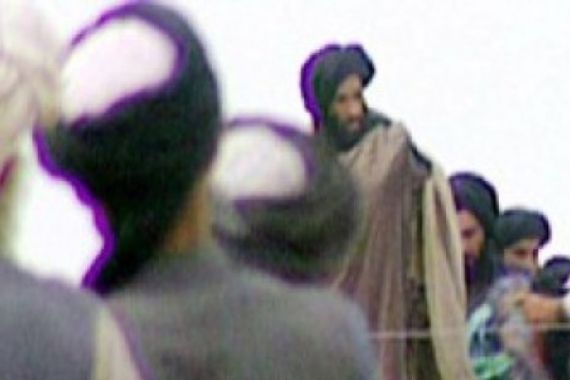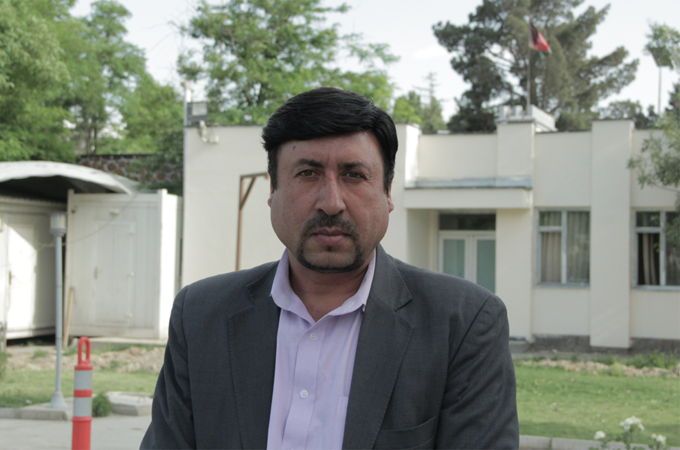The myth of Mullah Omar
Decade of war and a $10m bounty have only deepened the legend of the Taliban’s secretive, one-eyed spiritual leader.

Kabul, Afghanistan – A decade of the US-led NATO war against the Afghan Taliban has done little to erode the influence of one of the movement’s most powerful symbols: the one-eyed, deeply secretive spiritual leader, Mullah Omar.
The killing of Osama bin Laden in May 2011 greatly undermined the global reach and reputation of al-Qaeda. Despite battlefield victories and a $10m reward, the same success has eluded allied forces in their hunt for the shadowy leader of the Taliban.
Never seen and barely heard by most Afghans during his five-year rule, Omar was little more than an ever-increasiing myth. The perpetuation of that myth today is considered by many a nagging failure of NATO and a uniting factor for the Taliban.
The grinding corruption within the government of President Hamid Karzai has led Afghans in parts of the country to whisper his name and reputation for righteousness.
| Taliban rule still haunts Pakistani singers |
“No matter how much money we pour in, how hard I try, these people will stand by Mullah Omar for his perceived justice,” one senior official in Kandahar recalled telling an American general.
“They say the Taliban cleaned up this place [Kandahar] from vice; from dog-fighting and bird-fighting and sodomy.”
The rise of Mullah Omar is shrouded in mystery, but legends about him are everywhere.
According to one account, in the heat of the war against the Soviet Union, Omar continued fighting after shrapnel struck his right eye.
The pillaging and chaos that followed the Soviet withdrawal tried his patience, it is said, and the raping of a group of travelers by a local warlord in Kandahar led him to gather the ultraconservative force that became the Taliban.
Another account claims he was visited in a dream by the Prophet Mohammed, who revealed that Mullah Omar should lead the country out of chaos.
“Mullah Omar was a nobody, except for some brief glory from the anti-Soviet days,” said Omar Sharifi, an Afghan anthropologist and historian who has been a close observer of the Taliban from their early days.
“He was the most obscure character on the Kandahar political map. The invoking of an old myth was what helped him establish legitimacy.”
‘Masterstroke’
To formally announce his leadership in 1996, Mullah Omar, then 36 years old, brought forth the purported cloak of the Prohet Mohammed, one of Afghanistan’s most cherished Islamic relics.
For the first time since the reign of Ahmad Shah Abdali more than 250 years before, Omar donned the cloak in the presence of about 1,500 religious leaders, including the late Osama bin Laden.
“Wearing the cloak was a masterstroke,” Sharifi said, adding that it linked the ex-guerrilla fighter to both Abdali and the Prophet.
But Wahid Muzhda, an Afghan analyst and one-time high-ranking official in the Taliban foreign ministry, disputes that narrative.
“From what I know, from sources close to Omar, and from a chat with the keeper of the shrine [where the cloak is kept], Omar did not wear the cloak.”
“With great respect, he held the cloak in front of the religious leaders gathered for allegiance.”
This gesture, more than any other, was the impetus that allowed Mullah Omar, without any deep political or tribal base, to become the iron-fisted ruler of about 90 per cent of Afghanistan until the US invasion in 2001.
Perhaps his official title put it best: Commander of the Faithful, Emir of the Islamic Emirate of Afghanistan.
Organic or designed?
There is no consensus about the birth of the Taliban movement, or the hands behind it. Many, like Muzhda, believe the movement grew in response to the chaos following Soviet withdrawal. Backing from ISI, the Pakistani intelligence agency, came later, when they saw the movement’s potential, he said.
But others, like Sharifi, question that theory. The design for a movement like the Taliban existed long before Mullah Omar was picked as its chief, he said.
Sharifi explained that the power vacuum and social anarchy of the 1990s gave the Taliban and its leader a momentous rise – even past the expectations of their alleged benefactor, the ISI.
 |
| Radio anchor Sangar Niazai’s deep, “mountainous” voice fuelled the image of Mullah Omar as a larger-than-life figure [Mujib Mashal/Al Jazeera] |
“How do you create a movement in a tribal society that goes beyond the deeply rooted tensions between tribes?” Sharifi asked. “Through religious zeal, and through charisma of leadership. Mullah Omar had that charisma in his power of delivery.”
Such “charisma” was tightly controlled, some say by his almost complete absence from the public realm.
The spiritual leader of the Taliban received his only education at a seminary in Pakistan, according to some reports. Others suggest he was educated in local religious schools in Kandahar. Sharifi believes Mullah Omar did not have the capacity to sustain the myth that surrounded him.
Emal Pasarly, an Afghan journalist with BBC Pashto, has interviewed Mullah Omar three times by phone in four- or five-minute conversations that were recorded on the spot without prior arrangement. The last such conversation took place late in 2001, after US B-52 bombers had started pounding Taliban-controlled areas.
“The impression I was left with is that he either does not understand the nuances of issues, or that he is too smart and does not want to give clues on his inner thoughts,” Pasarly recalled.
Poet Bari Jahani remembers visiting Mullah Omar office with a delegation of Afghan academics and activists in the early days of Taliban rule. The room where they gathered was dark and windowless.
“Everybody was giving him praises; that he has a good system, that he has brought security,” Jahani recalled. By his account, the mullah was “tall and handsome” and listened in quiet.
“When it was my turn, I said, ‘I am sorry, most of what I have [to say] is bitter.'”
Jahani said he informed Mullah Omar about the discontent he perceived from people on trips to Kabul and Jalalabad about the strict religious measures imposed upon the country.
“Mullah Omar stared and stared and stared. Eventually, when I gave him the chance to respond, he stood up, hugged me, said ‘God be with you’ and left. That was it.”
Mountainous voice
If the leader was vague and mysterious, the mandates of the Taliban were not.
Women were prohibited from school and work. Television sets were outlawed. Photography was banned. Artists were threatened with imprisonment if they dared indulge in visual creation.
|
“On my own initiative, I sat behind the microphone and recited patriotic poems. The rest of the broadcast we filled with brief messages about the change of regime, and patriotic songs. There was no Taliban policy yet.” – Sangar Niazai |
The Taliban also banned music. Travellers crossing the Torkham border from Pakistan were greeted by broken instruments strung from a tree.
In the dearth of media, Mullah Omar became synonymous with his “sayings” beamed out on Radio Voice of Sharia, the only local broadcast service under the Taliban government.
But the mullah never spoke on Voice of Sharia; it was renowned anchor Sangar Niazai who read out the brief “sayings of the Commander of the Faithful”.
The day the Taliban captured Kabul, Niazai was one of only two who showed up for work at the radio station. The rest of the staff stayed home in fear.
“On my own initiative, I sat behind the microphone and recited patriotic poems,” Niazai said. “The rest of the broadcast we filled with brief messages about the change of regime, and patriotic songs. There was no Taliban policy yet.”
In the days that followed, Niazai’s deep, “mountainous” voice fuelled the image of Mullah Omar as a larger-than-life figure. Mullah Ishaq Nizami, who was then the newly appointed director general of radio, recited the more important messages.
“The director general was so enthusiastic that he wanted to read the news and the sayings in the morning, at noon, and also in the evening,” Niazai recalled. “We told him this is not your job. You are the director. We, the anchors, are supposed to be reading the news.”
It is believed that Mullah Omar slipped into Pakistan after the US invaded in 2001. Some US and Afghan reports place him in Karachi. He has issued several recorded and written messages from undisclosed locations over recent years.
Believed to be 52 years old, he remains at large; credible information about him is scarce. Even some of the grainy images of him that have circulated in the past near-decade have been disputed.
Mullah Omar may likely never come public, Sharifi has said, because the man could never match the myth.
Follow Mujib Mashal on Twitter: @MujMash